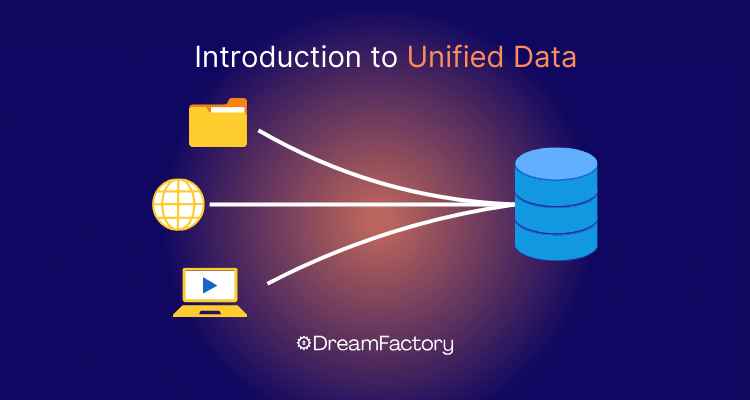Introduction to Unified Data: What Is It and Why Is It Important
by Terence Bennett • April 9, 2024

Today’s businesses rely on data to operate. Everything from collecting customer data to recording data points from business processes contributes to reaching goals. Big data doesn’t mean much, though, when you keep it separated in silos. When you unify data, you create more data analytics opportunities that lead to valuable insights. Before you spend a lot of money on a robust ETL (extract, transform, load) solution that you don’t need, consider the benefits of API-led data unity.
Here's a quick summary with everything you need to know about unified data:
- Unifying data sources offers benefits like predicting market trends, optimizing operations, and enhancing products/services.
- Key challenges include data fragmentation across silos, handling diverse data formats, and choosing the right unification tools.
- Data governance, data quality, and security/privacy are critical considerations for unified data environments.
- Effective data modeling techniques like enterprise data models and master data management are essential.
- Strategies for semi-structured/unstructured data include document data models, data lakes, text analytics, and metadata management.
Table of Contents
- Benefits of Unifying Data Sources
- The Challenges of Unifying Data
- What You Need to Know About Data Storage
- Data Modeling for Unified Environments
- Improve Your Approach to Data Unity With DreamFactory

Generate a full-featured, documented, and secure REST API in minutes.
Generate a full-featured, documented, and secure REST API in minutes.
Benefits of Unifying Data Sources
Before tackling the complicated issues associated with data unity, consider the numerous benefits that companies get when they find affordable ways to unify data. When you find a data unification process that works for your organization, you might find that you can:
- Use algorithms to predict emerging market trends
- Find the perfect pricing that will convince more customers to buy your products
- Optimize workflows to make your business operations more efficient
- Build a more effective customer journey that leads to higher revenues
- Improve employee retention by identifying signs they might feel like exploring opportunities outside of your business
- Connect datasets from multiple sources, including third-party vendors, applications, websites, and e-commerce platforms
- Monitor your network in real-time to discover minor issues before they become big problems
- Improve the functionality of your products and services
Simply connecting data sources will not give you these advantages. You also need to harness the power of machine learning algorithms that can spot trends within big data. Until you connect your data, though, machine learning never has an opportunity to create the results your business needs to move forward.
Recommended reading: The Power of Unlocking and Unifying Data
The Challenges of Unifying Data
Fragmentation is the biggest challenge between you and unified data. Right now, your data ecosystem might include diverse storage options like data lakes, data warehouses, and databases. You have structured datasets pulled from your company CRM and unstructured data from third-party vendors. The situation leads to data silos that prevent you from unlocking the true potential of your customer touch points.
The issue of unifying data becomes: how to get diverse data formats in several locations moved to one spot where you can use machine learning and visualization software to gain meaningful insight.
Some companies choose ETL platforms that can pull data from several sources, transform the information into a standard format, and load the standardized data into a single location. Unfortunately, ETL tools often cost a lot of money, and you often end up paying for features you don’t need.
API-driven solutions give you a more affordable option that can also perform tasks like:
- Setting API limits
- Creating APIs
- Generating API documents
- Managing APIs for web services and applications
With API-driven data unity, you get to combine databases and take control of your entire IT ecosystem.
Recommended reading: 7 Reasons You Need an API Integration Platform in the Age of API-First Development
What You Need to Know About Data Storage
If you don’t spend a lot of time working with data, you might think that eliminating data silos is simple. Why not connect them and get to work? Unfortunately, the world of data has a lot of variables that can stand between you and unification. The types of repositories and data formats are two such variables you need to consider in advance of unification.
Types of Data Repositories
Repositories describe the nature of the storage location for your data. Here are the most common types:
Data Lake
A data repository system that can store structured and unstructured data on-premises or in the cloud.
Data Mart
A small, highly organized system that usually holds specific data points.
Database
Any organized collection of data, including relational and non-relational options.
Data Warehouse
A repository that can store structured data from multiple sources, including CRMs and ERPs.
Popular Data Formats
To make the situation even more complicated, data comes in a growing number of formats. Some of the most popular formats include:
- SQL
- JSON
- CSV
- DOCX
- SAS
- TCT
- XLS
- PPT
- EPS
- AVI
- RAR
The type of format you have usually depends on the type of information you gather. Regardless, any business that collects data will end up with a collection of formats that cannot interact with each other.
Recommended reading: 7 API Design Trends
Thankfully, there are solutions like DreamFactory that can help you to achieve data unification even if you use multiple data repositories and data formats.
Data Modeling for Unified Environments
Designing effective data models is critical when unifying data from disparate sources into a cohesive environment. Like piecing together an intricate puzzle, a well-designed model provides the logical structure needed to integrate and relate different datasets, enabling seamless analysis and the generation of valuable insights.
Designing Enterprise Data Models
Enterprise data models aim to provide a comprehensive, integrated view of an organization's data assets – a single pane of glass, if you will. They define the entities, attributes, and relationships, serving as the blueprint that guides data unification efforts. Building these models is an exercise in diligence and attention to detail:
- Identifying Core Business Entities: First, pinpoint the critical entities (e.g., customers, products, orders) that drive your core business processes and decisions – the backbone of your operations.
- Mapping Data Sources: Next, thoroughly examine the various data sources containing information about these entities. Understand their structure, format, and how the pieces relate.
- Establishing a Unified Data Schema: With a clear picture of the components, it's time to design a cohesive schema that incorporates all relevant entities, attributes, and relationships. Resolving conflicts and redundancies across sources is like to untangling a knotted mess of threads.
- Normalizing and Optimizing: Apply proven database normalization principles to eliminate redundant data and optimize the model for performance and scalability.
- Iterative Refinement: Continuously refine the model as new data sources or business requirements emerge.
Handling Semi-Structured and Unstructured Data
While structured data from databases and applications can be relatively straightforward to wrangle, unifying semi-structured (e.g., JSON, XML) and unstructured (e.g., text, images, audio) data presents unique challenges akin to herding cats. Strategies for taming these unruly data types include:
- Document Data Models: NoSQL databases like MongoDB embrace flexible document data models perfectly suited for semi-structured data, allowing for nested structures and variable schemas – bringing order to the chaos.
- Data Lakes: Think of enterprise data lakes as a centralized data warehousing district, providing a repository for storing raw, unstructured data in its native format, enabling exploration and analysis.
- Text Analytics: Like a talented translator, Natural Language Processing (NLP) techniques can extract structured information from unstructured text data, facilitating integration with other data sources.
- Metadata Management: Maintaining comprehensive metadata (data about data) is the key that unlocks the value of unstructured data assets.

Generate a full-featured, documented, and secure REST API in minutes.
Generate a full-featured, documented, and secure REST API in minutes.
Improve Your Approach to Data Unity With DreamFactory
DreamFactory can simplify your approach to data unity through effective API management. DreamFactory lets you combine multiple databases and other data sources to give you a unified, overhead view of your information. The platform even helps you conform to your industry’s data compliance standards.
Start getting more value from your data today by starting your free trial with DreamFactory. Once you see how much easier data management becomes, you will never want to go back to your earlier data unity process.
Related Reading
TL;DR - GET AN AI SUMMARY
AI SUMMARY
READY TO BUILD YOUR API?
See how DreamFactory can automatically generate REST APIs for your database in minutes.
Try DreamFactory FreeTerence Bennett, CEO of DreamFactory, has a wealth of experience in government IT systems and Google Cloud. His impressive background includes being a former U.S. Navy Intelligence Officer and a former member of Google's Red Team. Prior to becoming CEO, he served as COO at DreamFactory Software.
























